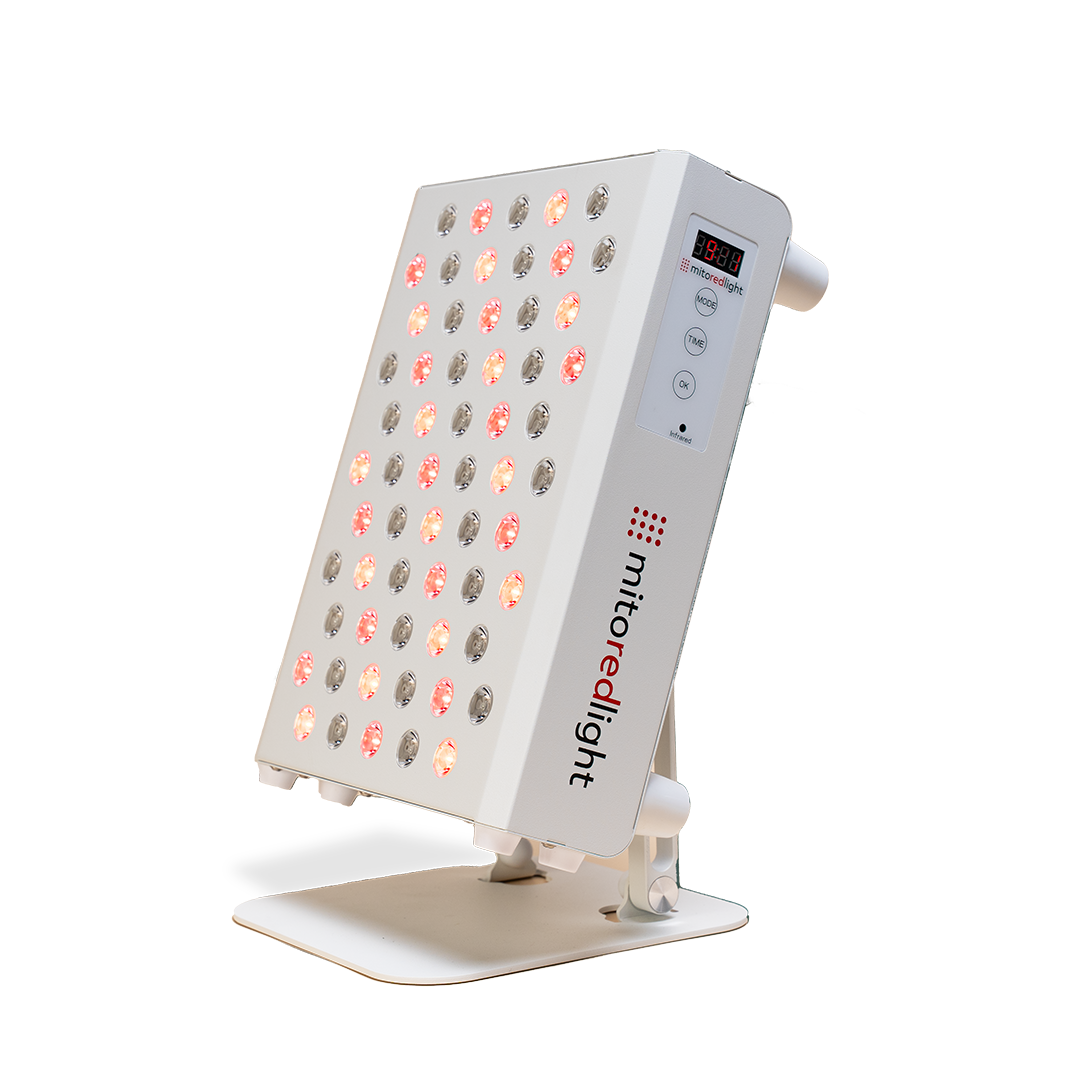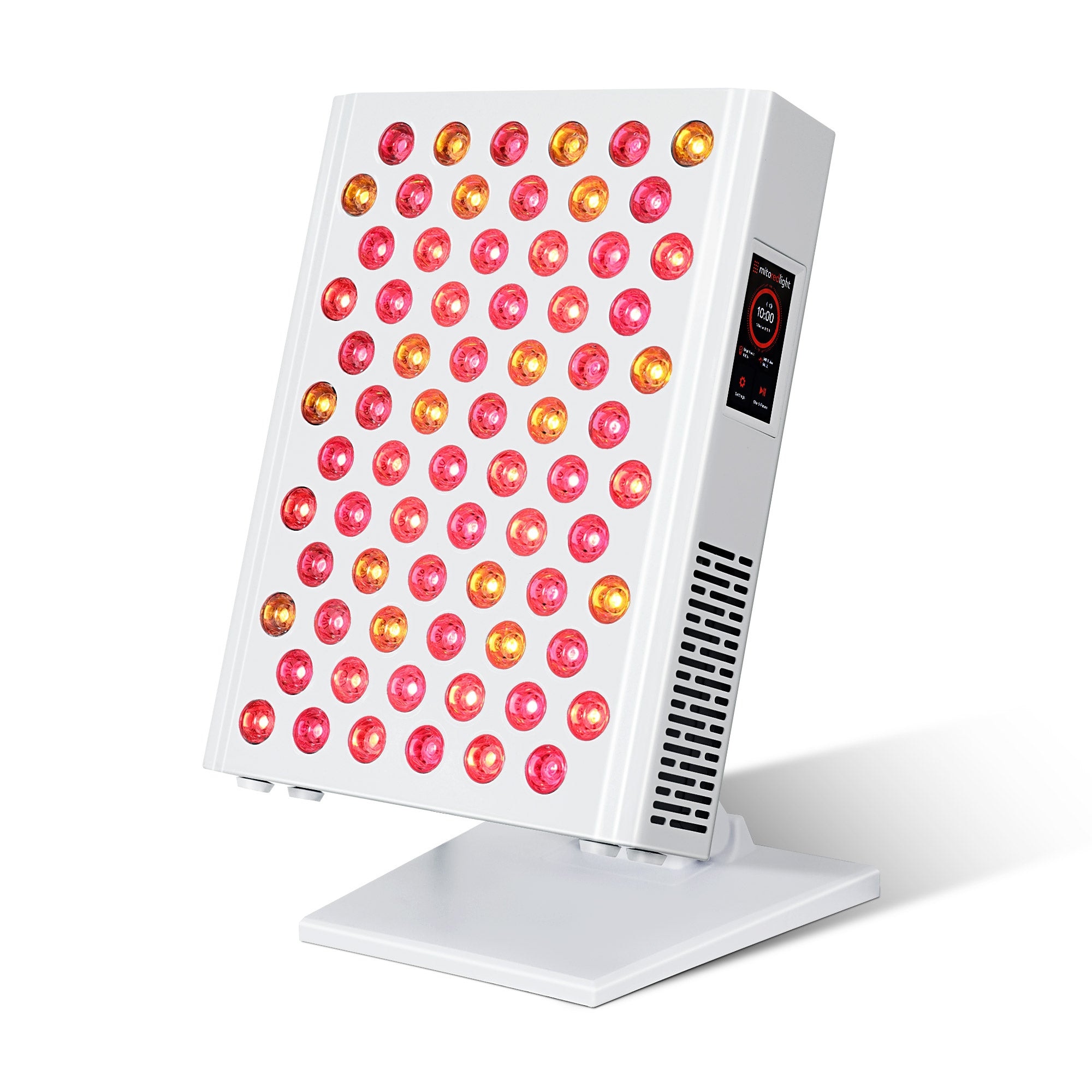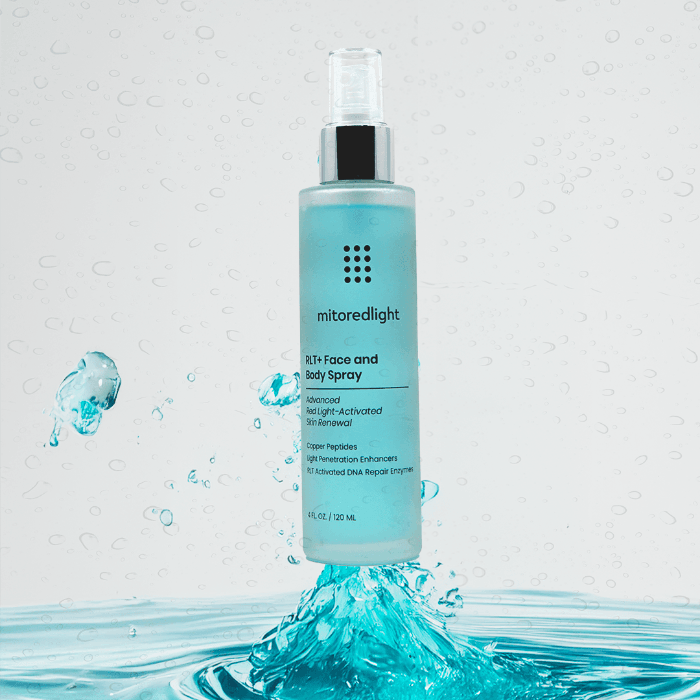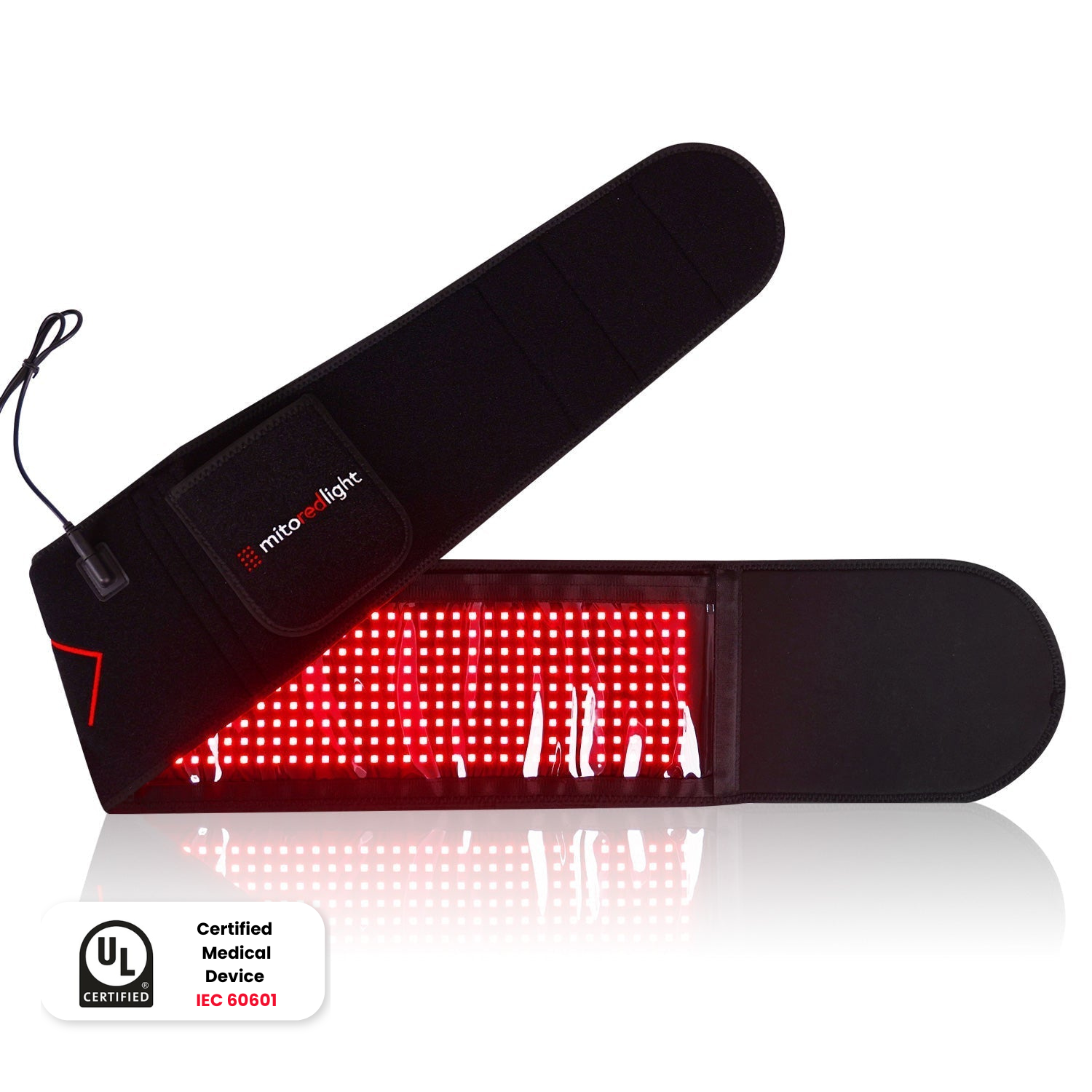DISCLAIMER: Mito Red Light devices are Class II wellness devices aimed at affecting the body through topical heating and supporting cellular function. The information provided in this article and on this site is for educational purposes only and is not intended to imply effectiveness of Mito Red Light devices for any specific application. The information provided in this article and on this site is not intended to diagnose, treat, cure, or prevent any disease, is not a substitute for consultation with a licensed medical provider and should not be construed as medical advice. Click here to read our article on potential contraindications of red light therapy..
Medically Reviewed by | Heidi Wright, BSN, RN, PCCN
Light therapy is a method of treating certain health conditions and rejuvenating the body. Before you dive into the benefits of using it, it’s important to understand there are several different types of light that can be used to address different concerns, and one type of light might be better for your goals than another.
At Mito Red Light, we have the inside scoop on how photobiomodulation and light therapy works. We’ll give you the information you need to make an informed decision about your light therapy, specifically as it pertains to the use of red versus blue light.
What Is Light Therapy?
Although it may pop up on your radar more frequently these days, light therapy, or the use of light to treat certain conditions or address certain issues, is not new. In fact, light therapy has its roots in ancient India, Egypt, and Greece, where records show that it was used both medically and as a form of physiotherapy.
Research into the use of light as therapy has expanded in the last few decades, allowing us to understand there are many more uses for light therapy than we once thought. For this reason, you probably see more light therapy products and users on your social media feeds and might even have access to light therapy at your local gym, doctor’s office, or medspa.
What’s the Purpose of Light Therapy?
Light therapy has beneficial uses that range from improved skin care to deeper sleep and workout performance.
Different wavelengths of light (read: different colors) can:
- Support mood, brain health, and cognitive performance
- Address skin concerns like acne, psoriasis, and eczema
- Target muscle and joint pain
- Improve and deepen sleep
- Support healthy hair growth
- Support wound healing and tissue repair
- Ease inflammation
- Support eye health
At first glance, it might look too good to be true, but research tells us that light therapy is both good and true. However, the type of light therapy you use is important. Some wavelengths of light are more beneficial than others, especially in terms of addressing certain issues.
What Are the Different Types of Light Therapy?
There are several different types of light therapy, including:
- UV light therapy (ultraviolet radiation)
- Yellow light therapy
- Blue light therapy
- Red light therapy
- Near-infrared light therapy
By far the most commonly used forms of light therapy are blue, red, and near-infrared (NIR) light therapy. These types of low-level light therapies (LLLT) offer restorative and targeted benefits with options that are non-invasive, effective, and have a much lower risk of side effects or complications than some other forms of treatment.
What Is Blue Light Therapy?
You’re probably familiar with blue light. In recent years it has become somewhat infamous for causing strain to the eyes, interfering with sleep patterns, and even leading to computer vision syndrome. “Most research on blue light damage focuses on high-intensity sources like industrial lighting. The blue light emitted from digital screens is significantly weaker, and its long-term effects remain unclear,” notes Heidi Wright, Registered Nurse. However, blue light isn’t entirely bad. As it turns out, it has some important skin-related benefits.
Blue light is part of the visible light spectrum emitted from the sun, but it also comes from devices like LED televisions, smartphones, computers, tablets, and LED light bulbs. The bad rap that blue light gets is due to our somewhat continual exposure to it.
However, blue light has a wavelength that is slightly longer and lower-energy than UV light. Its wavelength measures between 450 nanometers and 495 nanometers. When harnessed into the right channels of therapy, it can be used to address several different skin concerns and can even play a role in skin cancer therapy.
What Are the Benefits of Blue Light?
Blue light is predominantly used in dermatology. With its shorter, higher energy wavelengths, it can directly impact the skin without causing damage like prolonged exposure to UV light can. In fact, blue light is used to help treat skin damage that has developed from UV exposure.
Both precancerous and cancerous skin cells can be targeted with a specific type of blue light therapy known as photodynamic therapy. A dermatologist will use this therapy along with a photosensitizing skin cream, which makes the skin more sensitive to the light session.
Blue light is also effective in treating blemish-prone skin. Just like blue light can kill certain types of skin cancer cells, it can also kill some types of bacteria that cause acne. “Propionibacterium acnes (P. acnes), the bacteria that contributes to acne breakouts, is sensitive to specific blue light wavelengths. Blue light therapy may kill these bacteria, reducing inflammation and promoting clearer skin,” highlights Wright.
Are There Side Effects of Blue Light Therapy?
Blue light therapy’s effectiveness relies on photosensitivity in the skin. As such, after a session, you can expect side effects like:
- Irritation
- Increased sensitivity to UV rays
- Peeling and burning
These side effects usually last several days to a week before going away on their own. Your dermatologist can help you decide if blue light therapy is a good fit for you and if the possible side effects are worth the benefits.
For more benefits that target the skin and other parts of the body, you’ll want to consider red light therapy.
What Is Red Light Therapy?
Red light therapy is a type of light therapy that uses wavelengths of light that are longer and lower-energy than blue light. Red light has a wavelength that measures between 620 nanometers and 700 nanometers. NIR light measures between 800-900 nanometers.
At these wavelengths, red light can target deeper layers of the skin and even reach soft and hard tissue below the skin, including muscle and bone. Red light and NIR light do not contain UV rays and don’t damage skin or other tissue in the way that UV light can. This allows red light to provide benefits that other forms of light cannot.
How Does Red Light Therapy Work?
Red light therapy is incredibly beneficial because of the way it is able to interact with our cells. We all know that our cells are the foundational part of our bodies, making up all the tissues and organs that our bodies need to function.
Over time, our cells can begin to lose their function, and this impacts our bodies system-wide. Specifically, the mitochondria within our cells begin to make less cellular energy, called ATP. Red light actively stimulates mitochondria and helps them produce more cellular energy more efficiently.
Red light is absorbed by cytochrome C oxidase, a molecule directly involved with the way mitochondria produce ATP. By engaging this molecule, red light can increase cellular ATP levels and help cells function better.
What Are the Benefits of Red Light Therapy?
Red light therapy, unlike blue light therapy, is beneficial to more than just the skin, although its skin benefits are remarkable. Red light therapy can extend benefits to your bones, muscles, and even the brain.
- Dermatology. Red light targets fibroblasts, cells in the skin responsible for the production of both collagen and elastin. By targeting these cells, red light can support collagen production and help reduce the appearance of fine lines and wrinkles.
- Hair growth. Red light stimulates skin cell turnover, which can help stimulate and support healthy hair growth.
- Pain management. Pain and inflammation are targets for red light therapy benefits. Red light helps improve circulation and blood flow and also helps ease inflammation at the source of joint aches and muscle pains.
- Sleep. Unlike blue light, which can negatively impact the sleep cycle, red light has been shown to help deepen and support sleep.
- Improved physical performance. Used by professional athletes and at-home workout enthusiasts alike, red light helps speed up muscle recovery so you can get back in the game faster.
- Cognitive health. Red light therapy also has cognitive benefits, like mood support and improved neuroplasticity.
All of these benefits are available with red light therapy, and it’s available in a number of different places, including your own home.
Are There Any Side Effects of Red Light Therapy?
Unlike blue light, red light therapy doesn’t have any known side effects. If you have photosensitivity, or if you are taking a medication that makes you photosensitive, consult a doctor before beginning red light therapy sessions.
Fast Facts About Blue Light and Red Light
- Blue light and red light therapy can be used together, but keep in mind that blue light is most effective on skin that has been treated with a photosensitizing agent. Although there are no known side effects of red light therapy, combining red light and blue light can result in sensitive skin if the skin has been treated with a skin-sensitizing agent for the blue light session.
- You can’t “overdo” red light therapy. You can use it as much as you want, although 20 minutes per day is the therapeutic window for use. There’s no research that shows that more than this will net you any greater benefits.
- You can overuse blue light therapy, and cause extreme skin sensitivity. As such, it’s best to follow your dermatologist’s guidelines for use.
Both red light and blue light can be accessed at doctor’s offices, medspas, or at home.
How To Use Light Therapy at Home
To use light therapy at home, you’ll need to invest in a light therapy device. Light therapy devices are tools that emit blue or red lightwaves so you can target specific issues at home. However, blue light devices made for at-home use are generally lower in power and effectiveness than the devices your doctor has access to.
Devices for red light therapy at home can have the same powerful wavelengths that you’d find at a doctor’s office or a medspa, but not all devices are created equally. For red light devices you can trust, you want Mito Red Light.
Why Mito Red Light
Because red light therapy products aren’t as strictly regulated as other medical devices, it’s important to purchase a red light therapy device from a company you can trust to provide a high-quality therapeutic device.
Mito Red Light devices are high-quality, durable, and provide the most wavelengths of light per diode than our competitors.
Our Lights
From our red light therapy panels to our wearable and flexible devices, we include more diodes per square inch than our competitors. This cuts down on dead space and ensures you are getting as much coverage as possible when you use our therapies.
Our Testing
Our lights are third-party tested and diagnostically tested to ensure our RLT products are within the therapeutic window of treatment as defined by scientific testing and research.
Accessibility
Whether you need a red light helmet for hair growth and brain health or a light panel for skin rejuvenation, we’ve got you covered. Our wide selection of red light therapy devices is unmatched.
Advanced Technology
Our devices are specially formatted with Enhanced Spectral Energy Output™, a technology that delivers energy across all spectrums of red and NIR light. Our MitoPRO series offers multi-wavelengths that give you access to even more spectrums of red and NIR light and contains an even split of the four peak action spectra LEDs for even coverage.
Get Light On It
You may have specific skin concerns that would benefit from blue light therapy, however those issues are best addressed by a licensed dermatologist. Blue light works best with skin that is photosensitive, and provides results that come with temporary side effects.
For benefits that extend beyond the skin to your entire body, you’ll want red light therapy. Red light therapy has no negative side effects and helps support your body inside and out.
Sources:
Photobiomodulation: The Clinical Applications of Low-Level Light Therapy | PubMed
Wavelength of Blue and Red Light | Center for Science Education | Science.UCAR.edu
Blue Light Therapy for the Skin: What Can It Do? | Cleveland Clinic.org
Transcranial near-infrared light in treatment of neurodegenerative diseases | Frontiersin.org
Red Light and the Sleep Quality and Endurance Performance of Chinese Female Basketball Players | PMC























